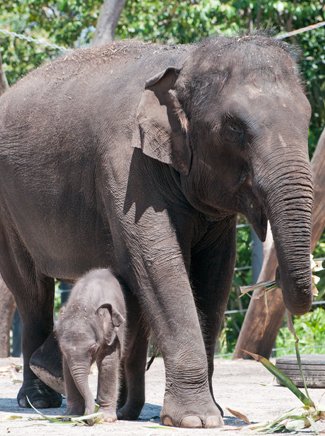How to make a baby elephant

FIVE HEFTY BUNDLES of joy that recently arrived at zoos in Sydney and Melbourne are symbols of conservation in action.
These baby elephants – each of which weighed between 96kg and 142kg at birth – are the result of Australasia’s first captive-breeding program for the endangered Asian elephant. And though they’re all still suckling, these inquisitive babes are already playing their part, both as important links in the genetic chain of Australia’s up-and-coming herd, and as ambassadors for wild elephants in Asia.
“Our elephants are storytellers,” says Simon Duffy, life sciences manager at Sydney’s Taronga Zoo. “They’re here to tell people that wild elephants are endangered and that if we don’t do something about it, these animals will become extinct.”
During the past three generations or so, wild Asian elephant numbers have halved according to the International Union for Conservation of Nature (IUCN), and there may be as few as 34,000 left, Simon says. “We need to create a safety net for these animals, an insurance policy against extinction in the wild.”
Elephant breeding a tricky business
The program began in November 2006 with the arrival of eight adults from Thailand, and it is working towards a healthy and genetically robust breeding herd that will also act as a flagship to raise funds for conservation in Thailand. The success rate has been remarkable.
“In four years we’ve bred five elephants, whereas up until the program began, no elephant had ever been bred in this country,” says Dr Larry Vogelnest, Taronga’s senior veterinarian. “To have five successful first-time-mother births is just phenomenal.”
“The Australian program is the most successful breeding program in the world based on the time it has been running,” agrees Dr Thomas Hildebrandt, the world expert on elephant reproduction at Berlin’s Institute for Zoo Biology and Wildlife Research in Germany.
The eight imported elephants included only one male, Gung, who now lives at Taronga. He fathered two of the babies naturally: Luk Chai, the first elephant born in Australia, and Tukta, the latest arrival. The sire of the other three babies (Mali, Pathi Harn and Ongard) is Bong Su, an older bull who was already at Melbourne. “Getting Bong Su into the breeding program was very, very important,” says Larry. “Genetically, he was valuable because he’d never bred before, and because he’s quite an old animal. It was a high priority to get him represented early on by pairing him with the imported [females].”
The art of artificial: making baby elephants
Although a natural mating is the easiest way to produce a baby, it isn’t always possible. Bong Su, for example, has never expressed the urge to mate, even when surrounded by young females. So to use his genes, vets turned to science.
Thomas and his team were called in to help artificially inseminate (AI) three of the imported cows. In short, AI involves collecting semen from the bulls, transporting it to where the procedure will take place, and then inserting it through a tube into the cervix of an ovulating female. This is repeated three times over several days.
Thomas says that the scheme will eventually be linked to existing programs in Europe and North America. He sees AI as a valuable tool through which the genetic diversity of captive populations can be maintained. “With the potential of the [Australian] herd, the Asian elephant as a species has a real chance to survive the next 100 years, even if the wild population declines dramatically.”
RELATED STORIES

